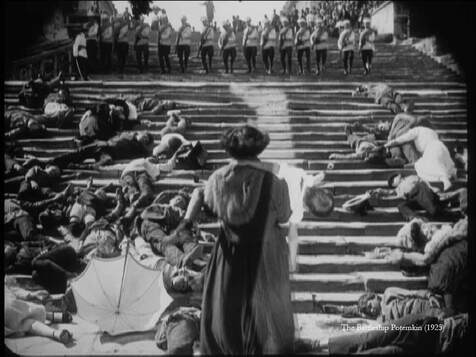|
by Michael Seymour Blake For some, 1925’s Battleship Potemkin was basically a horror movie. It was banned in France, The United Kingdom, and America due to fears it might incite a mass uprising. Let me repeat that. This film was banned in France, The United Kingdom, and America because they thought maybe a bunch of citizens would watch it and be like, “Let’s overthrow our government! Communism!” How horrifying! As of now it still holds the record for being banned longer than any other film in British history. But the best part is that it was eventually banned in The Soviet Union too. That’s right. This movie, which drips with Soviet ideology, was banned by Stalin because even he worried it would cause people to revolt. That’s one terrifyingly powerful film. But it’s not only famous for the sociopolitical weight of its story, the movie also showcases some incredible examples of montage that people still oogle over today. And the Odessa steps sequence itself. Whew! Still shocking and affecting. The movie doesn’t give us much of a backstory, it simply shows us a situation and unrolls from there. You don’t need to know more than that. Still, it’s nice to have a barebones understanding of the historical context. By 1905, the Russian Empire was riddled with social unrest. Multiple defeats in The Russo-Japanese War further stirred feelings of discontent and disillusionment. Revolution seemed imminent. Millions of dissatisfied workers were on strike, and naval mutinies began to spread. One of these mutinies took place on the Knyaz Potemkin Tavricheskiy. That’s our ship. We’re quickly aligned with the already-agitated Black Sea Fleet crew, who are abused and disparaged by the officers in charge. After they refuse to eat maggot-infested meat, the ship’s doctor is called for a public inspection. He clearly ignores the squirming insects and asserts (in title cards) “Those aren’t maggots.” They are, he claims, simply dead fly eggs. The crew rejects the rotten meat. The ship’s captain, tired of everyone’s complaints, doubles down. He separates those who are “dissatisfied” with the food and condemns them to death. But before the assembled firing squad carries out their sentence, a heroic sailor named Vakulinchuk shouts, “Brothers! Who are you firing on?” His words give them pause. They lower their weapons. An officer tries to reassert control, grabbing for one of the rifles. Then total chaos erupts. The firing squad joins the crew in mutiny. Vakulinchuk is killed in the skirmish. After successfully commandeering the ship, the crew ports at Odessa and displays Vakulinchuk’s body for all to see. The citizens are roused into action, sending skiffs packed with supplies to the mutineers. But czarist troops appear at the top of a long flight of steps and descend on the crowd like one barbarous creature, killing without restraint or mercy. The ending is suspenseful, but don’t expect a ton of excitement after the famous Odessa steps sequence (how could it possibly get better than that anyway?). Propaganda doesn't have to work as a great piece of art, but this movie is both. While modern audiences might be a little bored at times, an underlying vigor keeps this cinematic ship afloat (sorry). Director Sergei Eisenstein said, “Language is much closer to film than painting is.” And there is poetry here; semi-surrealistic images of ghostly hanging sailors, a priest who looks like he belongs in Clash of the Titans, and three lion statues cleverly edited to give the impression of one waking beast all contribute to a feeling of watching an ode on the screen. The outbursts of violence rival almost any other movie I can think of, at least on an emotional level. Stanley Kauffmann describes the overall feel of the film as “extraordinary eavesdropping,” and that’s one reason why it packs such a punch. At times I was so invested it seemed like I was watching real footage some creative weirdo had shot and stored in their basement. At one point, the camera cuts to a woman who’s been brutally slashed in the face. There’s no story arc for her as we’ve only just “met” her moments prior. Yet she doesn’t feel expendable. We grieve her loss because she represents the people, and this is largely a story about groups, not individuals. Their deaths are everybody’s deaths. In fact, the ship itself reads as a kind of mass entity… like how some ants can interlock themselves into a raft for crossing bodies of water. The ship becomes the people. Or the people become the ship? Now I’m babbling. Despite Battleship Potemkin’s legendary status and it being nearly 100 years old, I don’t meet many people who have seen it (outside of film-loving circles and some students). If you haven’t yet, I encourage you to—and not just for the Odessa steps sequence. It’s an important piece of work that explored what montage (which is basically editing) is capable of. Notice how and when the cuts occur. Something’s always being said. We take much of these things for granted now, but back then this was some truly wild stuff. Eisenstein ideally wanted the score to be rewritten every 20 years so it could remain relevant to newer generations. A cool idea that’s, for me, unnecessary. What’s presented to us works as is. Simple. Direct. Inspiring. Hell, Potemkin radiates sonic energy even without any soundtrack. This movie is a warning: Don’t tell people that maggots aren’t maggots, literally or symbolically.
Comments are closed.
|
AuthorOur fabulous blog team Archives
June 2024
CategoriesAll 12 Songs Art Art And Athletes Book Review Chorus Blog Date This Book Game Of Narratives Guest Blog Letter From The Editor Lifehacks Movies Of 2019 Music Pup Sounds Smackdown Strive For 55 Summer Playlists |






 RSS Feed
RSS Feed